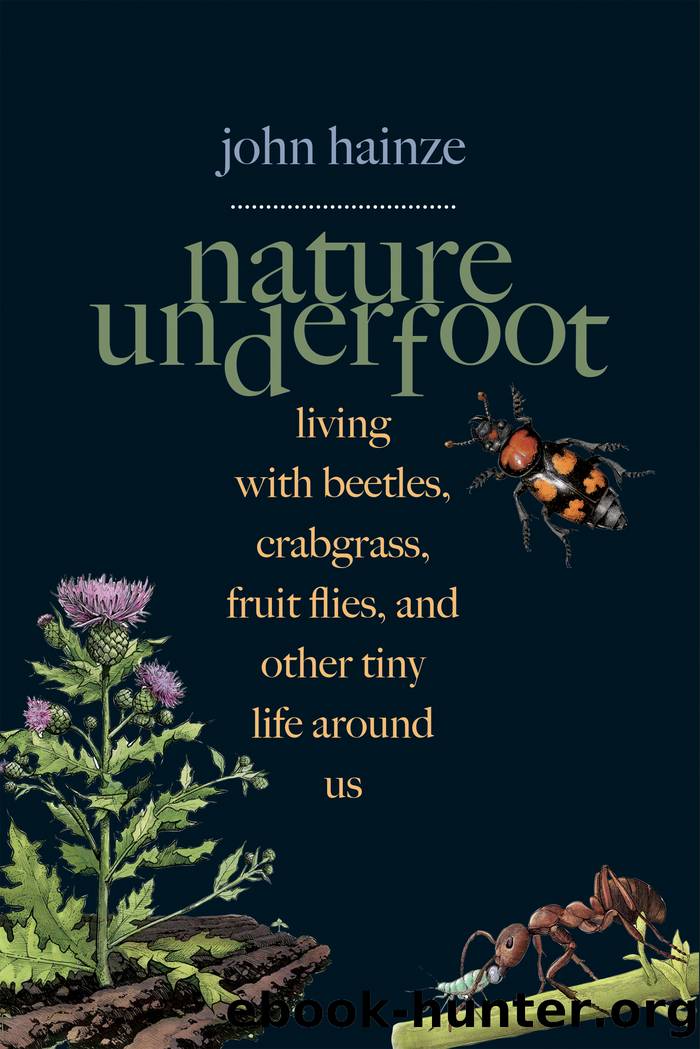Nature Underfoot: Living With Beetles, Crabgrass, Fruit Flies, and Other Tiny Life Around Us by John Hainze

Author:John Hainze [Hainze, John]
Language: eng
Format: epub
Tags: nature, animals, Insects & Spiders, science, Life Sciences, Microbiology, Environmental Conservation & Protection
ISBN: 9780300252682
Google: JLHNDwAAQBAJ
Publisher: Yale University Press
Published: 2020-02-18T00:24:36.475523+00:00
Several hundred years ago, most people, including scientists, did not think extinctions were possible. Our ability to conceive of extinction was limited by a static understanding of creationâthe plants and animals present on earth had been there since the beginning. It seemed even less likely that human beings could directly cause the extinction of another species. Yet it was a little more than three hundred years ago that sailors hunted the dodo to extinction on the island of Mauritius. And, finally, it has been a little over two hundred years since the concept of extinction was accepted by science. Now, many scientists believe we are entering an Anthropocene extinction event generated by human activity.
Our understanding of biology changed significantly with the development of the theory of evolution. We now recognize that species come and go with regularity in natureâa possibility faced even by our own species. Nature is âred in tooth and claw,â according to Tennyson, and we accept that species must constantly adapt to changes in their environment to survive.5 Entomologists speak of an evolutionary arms race, in which plants develop new chemical defenses against the insects that feed on them, and insects evolve metabolic countermeasures that allow them to detoxify those chemicals. But human-caused extinctions somehow seem different. The Endangered Species Act in the United States refers to the âesthetic, ecological, educational, historical, recreational, and scientific value to the Nation and its peopleâ of endangered species. The Endangered Species Act suggests that we should take action when we can prevent extinctions resulting from âeconomic growth and development untempered by adequate concern and conservation.â6
Decisions to conserve species, and their habitats, become more difficult the more that a species is inconvenient to us. Are we willing to slow down in certain stretches of roadway to save the Hineâs emerald dragonfly? Or does that idea seem rather comical? Are we willing to support more expensive oil and gas or real estate development to preserve populations of the American burying beetle? Moving further along the scale of inconvenience, should we try to eliminate the mosquito species that transmit malaria? We can agree that there might be a difference in organisms that are a danger to humans, such as the bubonic plague bacteria, as opposed to organisms that are an economic inconvenience. But there is also an ethical aspect to these questions. We will discuss this further in the final chapter, but here consider that the lives of other organisms may have value just as we believe human lives have valueâand not just in their instrumental value to humans. The Endangered Species Act refers to the value of endangered organisms to the nation and its people. But does an organism that has survived for several hundred million years not have a value of its own that is independent of humans? Donât we have a responsibility to mitigate the impact of our actions on other species irrespective of whether they are useful to us?
Beyond remediation, and survival of a species, can we conceive of
Download
This site does not store any files on its server. We only index and link to content provided by other sites. Please contact the content providers to delete copyright contents if any and email us, we'll remove relevant links or contents immediately.
| Administration & Medicine Economics | Allied Health Professions |
| Basic Sciences | Dentistry |
| History | Medical Informatics |
| Medicine | Nursing |
| Pharmacology | Psychology |
| Research | Veterinary Medicine |
Machine Learning at Scale with H2O by Gregory Keys | David Whiting(4179)
Fairy Tale by Stephen King(3220)
Will by Will Smith(2793)
Hooked: A Dark, Contemporary Romance (Never After Series) by Emily McIntire(2500)
Rationality by Steven Pinker(2291)
Friends, Lovers, and the Big Terrible Thing by Matthew Perry(2119)
The Becoming by Nora Roberts(2087)
Love on the Brain by Ali Hazelwood(1965)
HBR's 10 Must Reads 2022 by Harvard Business Review(1777)
The Strength In Our Scars by Bianca Sparacino(1776)
A Short History of War by Jeremy Black(1762)
Leviathan Falls (The Expanse Book 9) by James S. A. Corey(1650)
515945210 by Unknown(1599)
A Game of Thrones (The Illustrated Edition) by George R. R. Martin(1589)
Bewilderment by Richard Powers(1539)
443319537 by Unknown(1470)
The 1619 Project by Unknown(1387)
The Real Anthony Fauci: Bill Gates, Big Pharma, and the Global War on Democracy and Public Health (Childrenâs Health Defense) by Robert F. Kennedy(1366)
Fear No Evil by James Patterson(1278)
